Multimedia Real-time Video Streaming
VerifiedAdded on 2023/03/30
|17
|3768
|88
AI Summary
This document provides an overview of multimedia real-time video streaming, including its technology, communication techniques, and application features. It also explores the multimedia streaming of YouTube and its features.
Contribute Materials
Your contribution can guide someone’s learning journey. Share your
documents today.
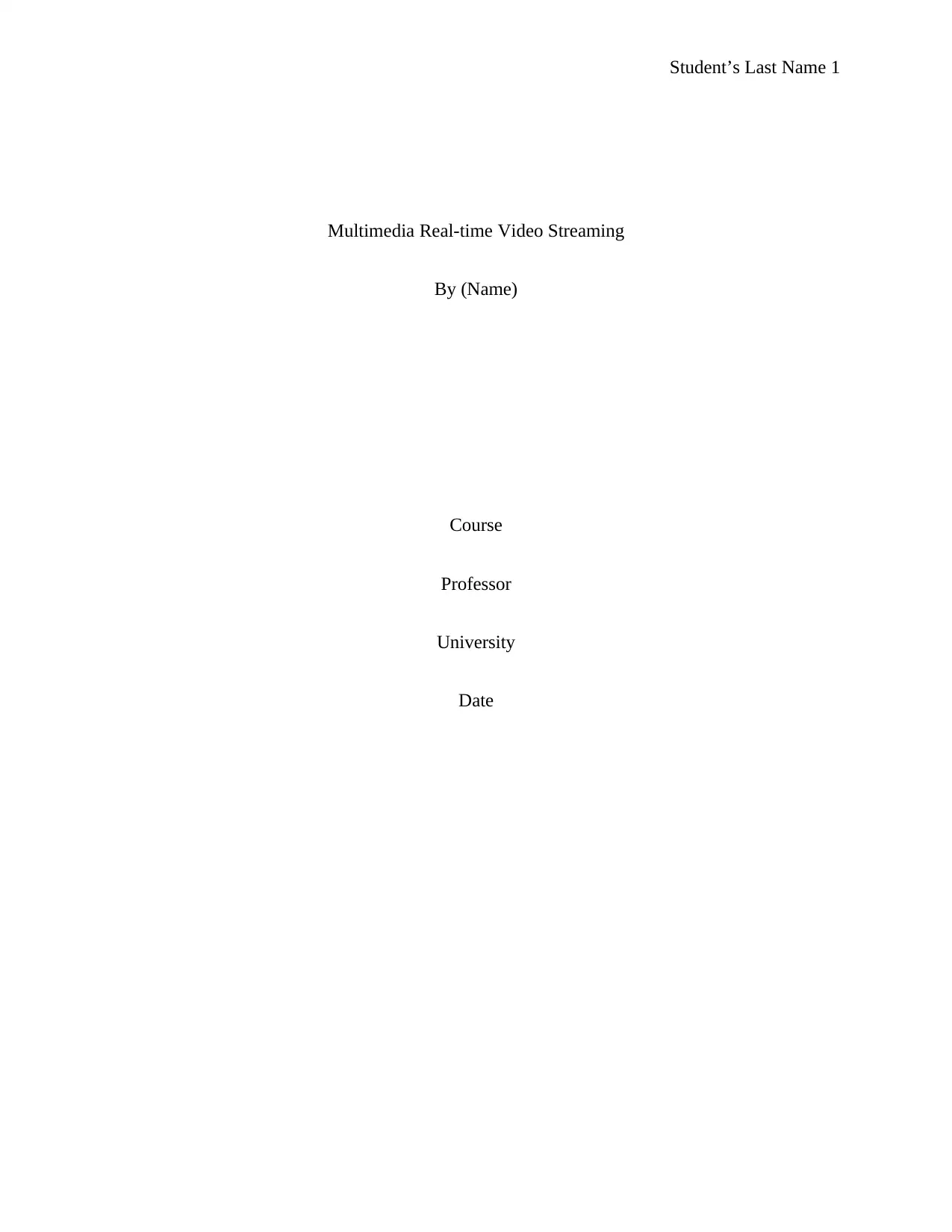
Student’s Last Name 1
Multimedia Real-time Video Streaming
By (Name)
Course
Professor
University
Date
Multimedia Real-time Video Streaming
By (Name)
Course
Professor
University
Date
Secure Best Marks with AI Grader
Need help grading? Try our AI Grader for instant feedback on your assignments.
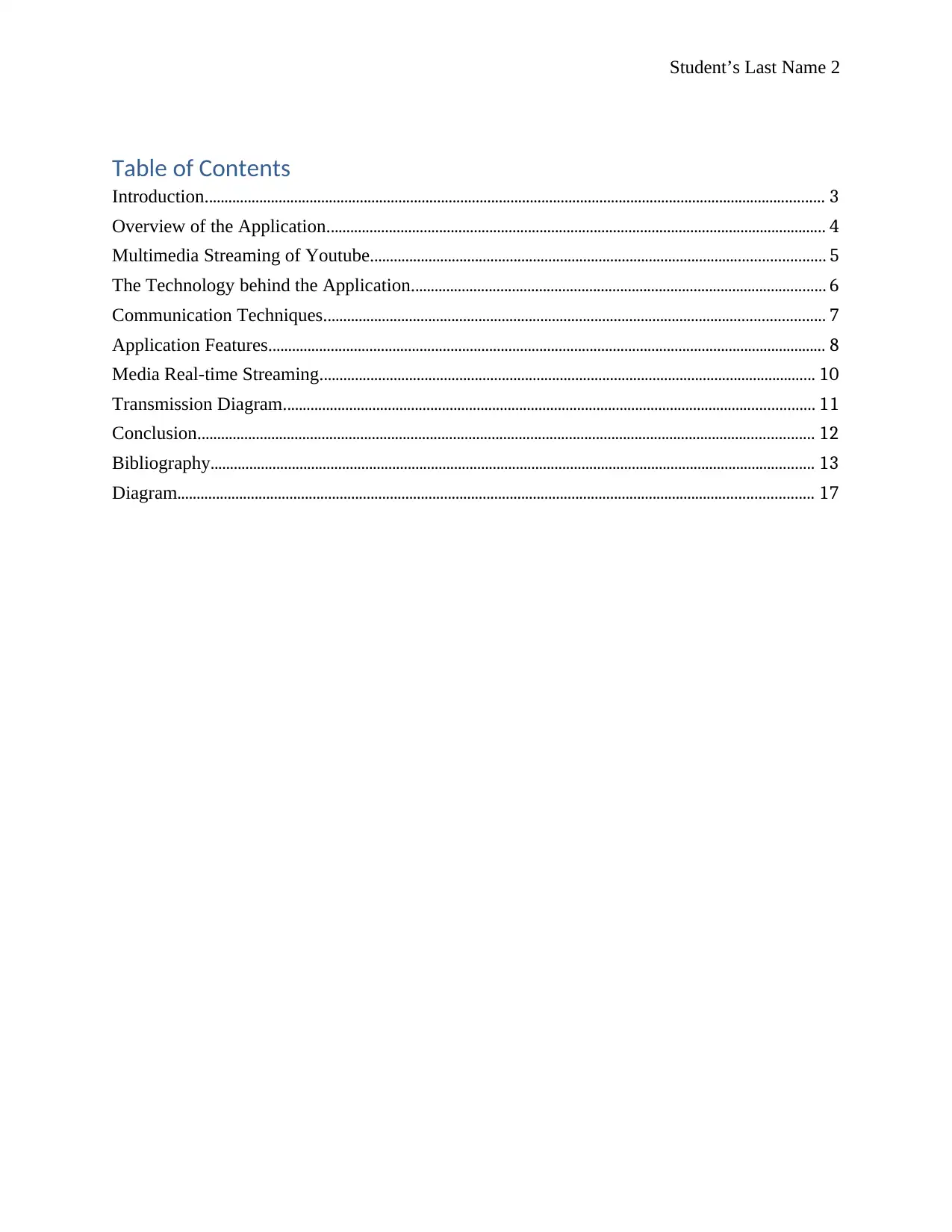
Student’s Last Name 2
Table of Contents
Introduction................................................................................................................................................................ 3
Overview of the Application................................................................................................................................. 4
Multimedia Streaming of Youtube..................................................................................................................... 5
The Technology behind the Application........................................................................................................... 6
Communication Techniques................................................................................................................................. 7
Application Features................................................................................................................................................ 8
Media Real-time Streaming................................................................................................................................ 10
Transmission Diagram......................................................................................................................................... 11
Conclusion............................................................................................................................................................... 12
Bibliography............................................................................................................................................................ 13
Diagram.................................................................................................................................................................... 17
Table of Contents
Introduction................................................................................................................................................................ 3
Overview of the Application................................................................................................................................. 4
Multimedia Streaming of Youtube..................................................................................................................... 5
The Technology behind the Application........................................................................................................... 6
Communication Techniques................................................................................................................................. 7
Application Features................................................................................................................................................ 8
Media Real-time Streaming................................................................................................................................ 10
Transmission Diagram......................................................................................................................................... 11
Conclusion............................................................................................................................................................... 12
Bibliography............................................................................................................................................................ 13
Diagram.................................................................................................................................................................... 17
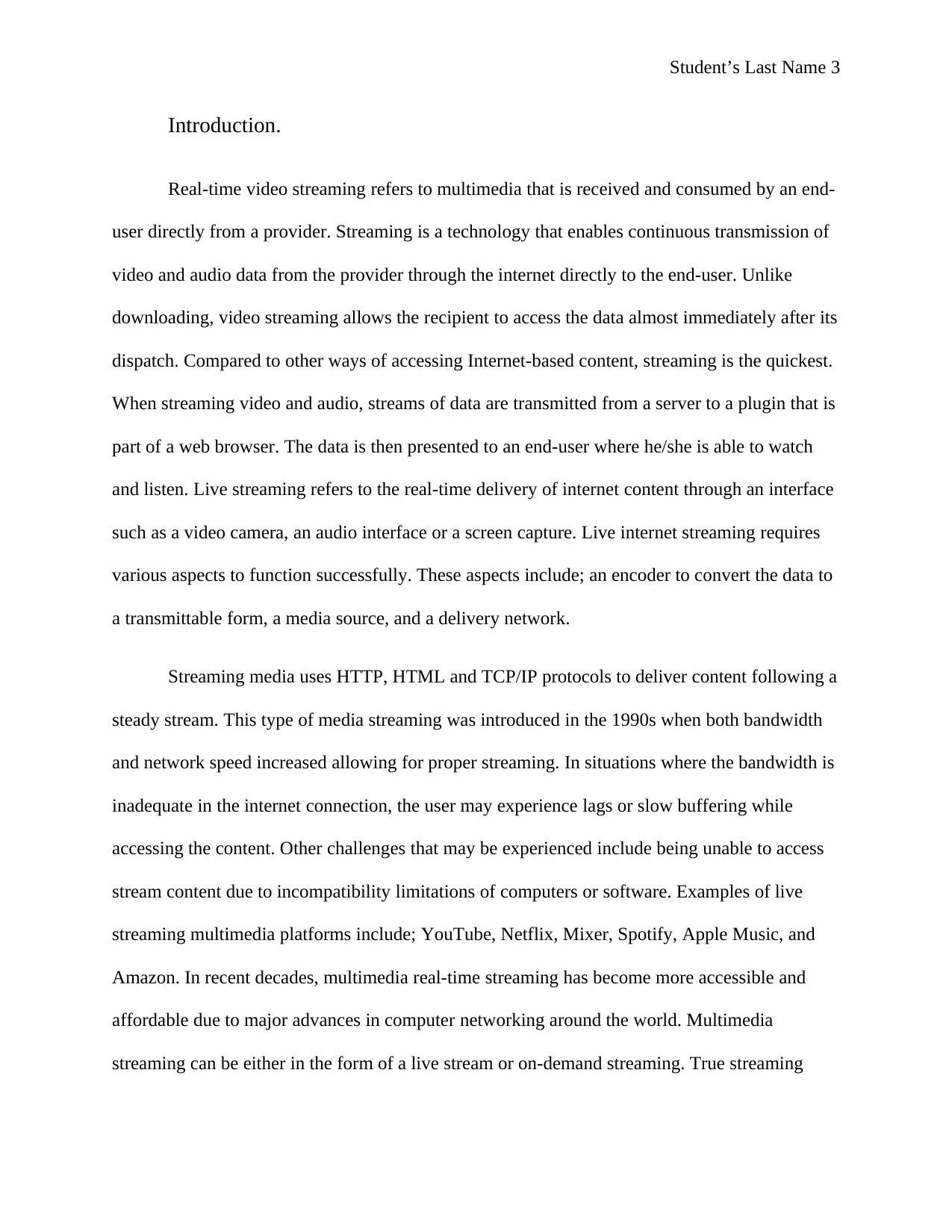
Student’s Last Name 3
Introduction.
Real-time video streaming refers to multimedia that is received and consumed by an end-
user directly from a provider. Streaming is a technology that enables continuous transmission of
video and audio data from the provider through the internet directly to the end-user. Unlike
downloading, video streaming allows the recipient to access the data almost immediately after its
dispatch. Compared to other ways of accessing Internet-based content, streaming is the quickest.
When streaming video and audio, streams of data are transmitted from a server to a plugin that is
part of a web browser. The data is then presented to an end-user where he/she is able to watch
and listen. Live streaming refers to the real-time delivery of internet content through an interface
such as a video camera, an audio interface or a screen capture. Live internet streaming requires
various aspects to function successfully. These aspects include; an encoder to convert the data to
a transmittable form, a media source, and a delivery network.
Streaming media uses HTTP, HTML and TCP/IP protocols to deliver content following a
steady stream. This type of media streaming was introduced in the 1990s when both bandwidth
and network speed increased allowing for proper streaming. In situations where the bandwidth is
inadequate in the internet connection, the user may experience lags or slow buffering while
accessing the content. Other challenges that may be experienced include being unable to access
stream content due to incompatibility limitations of computers or software. Examples of live
streaming multimedia platforms include; YouTube, Netflix, Mixer, Spotify, Apple Music, and
Amazon. In recent decades, multimedia real-time streaming has become more accessible and
affordable due to major advances in computer networking around the world. Multimedia
streaming can be either in the form of a live stream or on-demand streaming. True streaming
Introduction.
Real-time video streaming refers to multimedia that is received and consumed by an end-
user directly from a provider. Streaming is a technology that enables continuous transmission of
video and audio data from the provider through the internet directly to the end-user. Unlike
downloading, video streaming allows the recipient to access the data almost immediately after its
dispatch. Compared to other ways of accessing Internet-based content, streaming is the quickest.
When streaming video and audio, streams of data are transmitted from a server to a plugin that is
part of a web browser. The data is then presented to an end-user where he/she is able to watch
and listen. Live streaming refers to the real-time delivery of internet content through an interface
such as a video camera, an audio interface or a screen capture. Live internet streaming requires
various aspects to function successfully. These aspects include; an encoder to convert the data to
a transmittable form, a media source, and a delivery network.
Streaming media uses HTTP, HTML and TCP/IP protocols to deliver content following a
steady stream. This type of media streaming was introduced in the 1990s when both bandwidth
and network speed increased allowing for proper streaming. In situations where the bandwidth is
inadequate in the internet connection, the user may experience lags or slow buffering while
accessing the content. Other challenges that may be experienced include being unable to access
stream content due to incompatibility limitations of computers or software. Examples of live
streaming multimedia platforms include; YouTube, Netflix, Mixer, Spotify, Apple Music, and
Amazon. In recent decades, multimedia real-time streaming has become more accessible and
affordable due to major advances in computer networking around the world. Multimedia
streaming can be either in the form of a live stream or on-demand streaming. True streaming
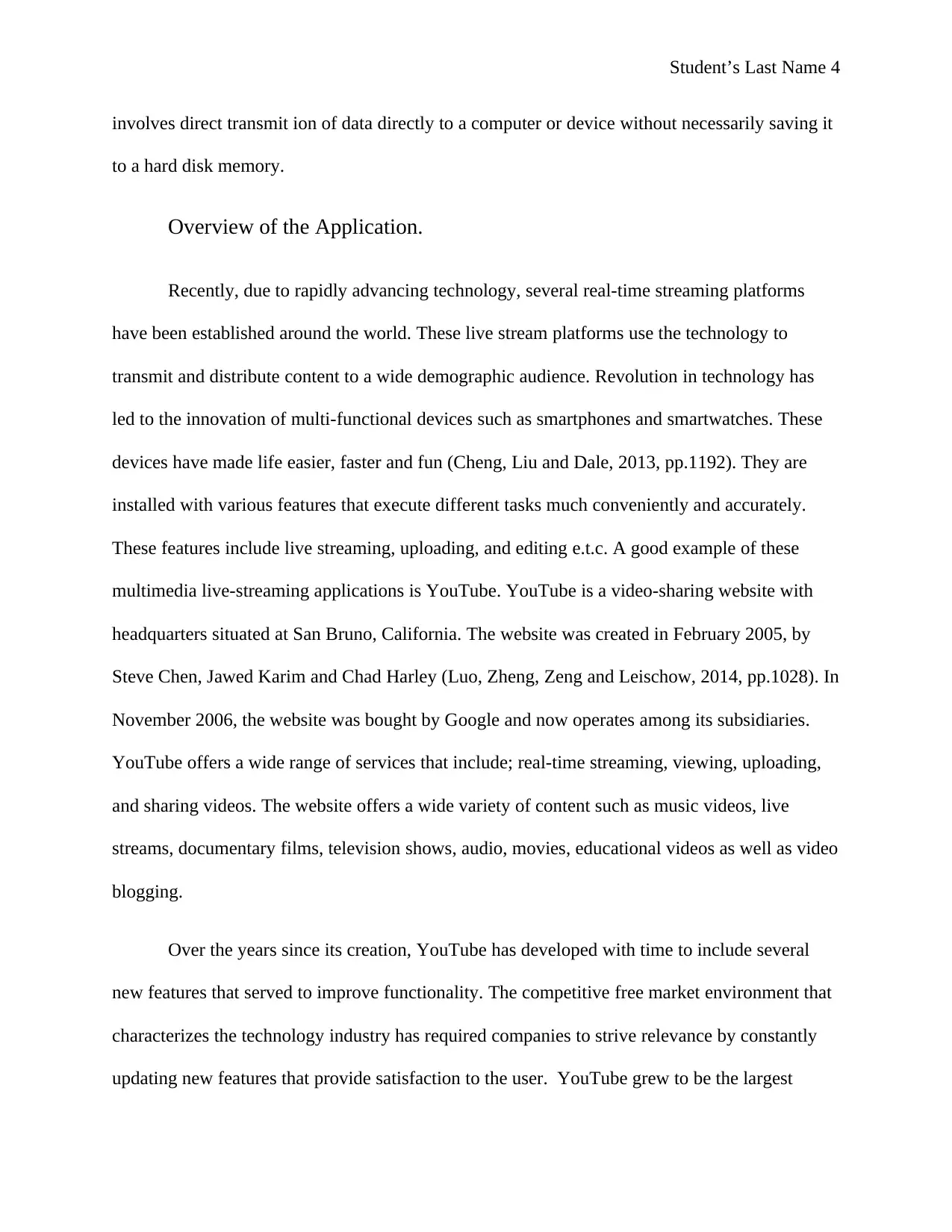
Student’s Last Name 4
involves direct transmit ion of data directly to a computer or device without necessarily saving it
to a hard disk memory.
Overview of the Application.
Recently, due to rapidly advancing technology, several real-time streaming platforms
have been established around the world. These live stream platforms use the technology to
transmit and distribute content to a wide demographic audience. Revolution in technology has
led to the innovation of multi-functional devices such as smartphones and smartwatches. These
devices have made life easier, faster and fun (Cheng, Liu and Dale, 2013, pp.1192). They are
installed with various features that execute different tasks much conveniently and accurately.
These features include live streaming, uploading, and editing e.t.c. A good example of these
multimedia live-streaming applications is YouTube. YouTube is a video-sharing website with
headquarters situated at San Bruno, California. The website was created in February 2005, by
Steve Chen, Jawed Karim and Chad Harley (Luo, Zheng, Zeng and Leischow, 2014, pp.1028). In
November 2006, the website was bought by Google and now operates among its subsidiaries.
YouTube offers a wide range of services that include; real-time streaming, viewing, uploading,
and sharing videos. The website offers a wide variety of content such as music videos, live
streams, documentary films, television shows, audio, movies, educational videos as well as video
blogging.
Over the years since its creation, YouTube has developed with time to include several
new features that served to improve functionality. The competitive free market environment that
characterizes the technology industry has required companies to strive relevance by constantly
updating new features that provide satisfaction to the user. YouTube grew to be the largest
involves direct transmit ion of data directly to a computer or device without necessarily saving it
to a hard disk memory.
Overview of the Application.
Recently, due to rapidly advancing technology, several real-time streaming platforms
have been established around the world. These live stream platforms use the technology to
transmit and distribute content to a wide demographic audience. Revolution in technology has
led to the innovation of multi-functional devices such as smartphones and smartwatches. These
devices have made life easier, faster and fun (Cheng, Liu and Dale, 2013, pp.1192). They are
installed with various features that execute different tasks much conveniently and accurately.
These features include live streaming, uploading, and editing e.t.c. A good example of these
multimedia live-streaming applications is YouTube. YouTube is a video-sharing website with
headquarters situated at San Bruno, California. The website was created in February 2005, by
Steve Chen, Jawed Karim and Chad Harley (Luo, Zheng, Zeng and Leischow, 2014, pp.1028). In
November 2006, the website was bought by Google and now operates among its subsidiaries.
YouTube offers a wide range of services that include; real-time streaming, viewing, uploading,
and sharing videos. The website offers a wide variety of content such as music videos, live
streams, documentary films, television shows, audio, movies, educational videos as well as video
blogging.
Over the years since its creation, YouTube has developed with time to include several
new features that served to improve functionality. The competitive free market environment that
characterizes the technology industry has required companies to strive relevance by constantly
updating new features that provide satisfaction to the user. YouTube grew to be the largest
Secure Best Marks with AI Grader
Need help grading? Try our AI Grader for instant feedback on your assignments.
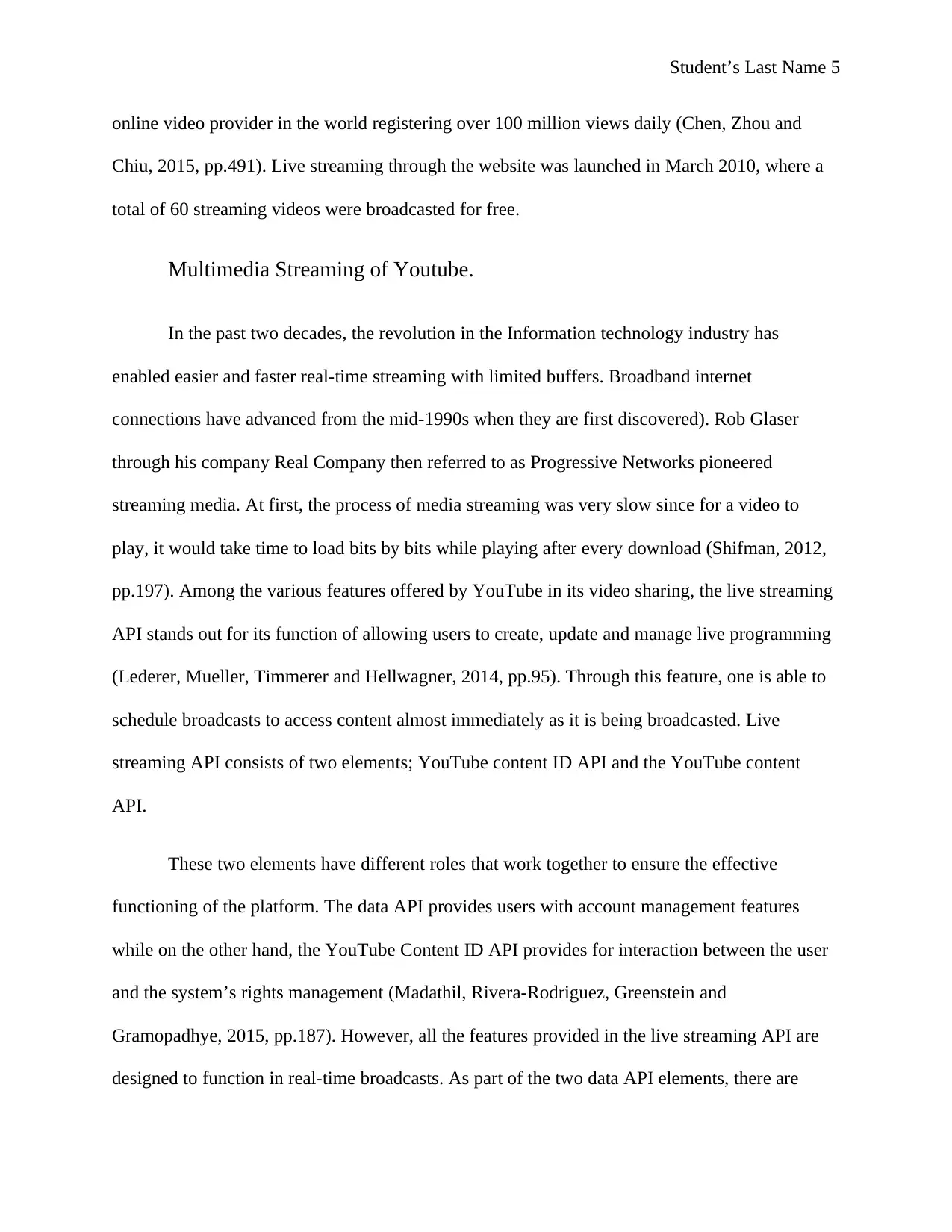
Student’s Last Name 5
online video provider in the world registering over 100 million views daily (Chen, Zhou and
Chiu, 2015, pp.491). Live streaming through the website was launched in March 2010, where a
total of 60 streaming videos were broadcasted for free.
Multimedia Streaming of Youtube.
In the past two decades, the revolution in the Information technology industry has
enabled easier and faster real-time streaming with limited buffers. Broadband internet
connections have advanced from the mid-1990s when they are first discovered). Rob Glaser
through his company Real Company then referred to as Progressive Networks pioneered
streaming media. At first, the process of media streaming was very slow since for a video to
play, it would take time to load bits by bits while playing after every download (Shifman, 2012,
pp.197). Among the various features offered by YouTube in its video sharing, the live streaming
API stands out for its function of allowing users to create, update and manage live programming
(Lederer, Mueller, Timmerer and Hellwagner, 2014, pp.95). Through this feature, one is able to
schedule broadcasts to access content almost immediately as it is being broadcasted. Live
streaming API consists of two elements; YouTube content ID API and the YouTube content
API.
These two elements have different roles that work together to ensure the effective
functioning of the platform. The data API provides users with account management features
while on the other hand, the YouTube Content ID API provides for interaction between the user
and the system’s rights management (Madathil, Rivera-Rodriguez, Greenstein and
Gramopadhye, 2015, pp.187). However, all the features provided in the live streaming API are
designed to function in real-time broadcasts. As part of the two data API elements, there are
online video provider in the world registering over 100 million views daily (Chen, Zhou and
Chiu, 2015, pp.491). Live streaming through the website was launched in March 2010, where a
total of 60 streaming videos were broadcasted for free.
Multimedia Streaming of Youtube.
In the past two decades, the revolution in the Information technology industry has
enabled easier and faster real-time streaming with limited buffers. Broadband internet
connections have advanced from the mid-1990s when they are first discovered). Rob Glaser
through his company Real Company then referred to as Progressive Networks pioneered
streaming media. At first, the process of media streaming was very slow since for a video to
play, it would take time to load bits by bits while playing after every download (Shifman, 2012,
pp.197). Among the various features offered by YouTube in its video sharing, the live streaming
API stands out for its function of allowing users to create, update and manage live programming
(Lederer, Mueller, Timmerer and Hellwagner, 2014, pp.95). Through this feature, one is able to
schedule broadcasts to access content almost immediately as it is being broadcasted. Live
streaming API consists of two elements; YouTube content ID API and the YouTube content
API.
These two elements have different roles that work together to ensure the effective
functioning of the platform. The data API provides users with account management features
while on the other hand, the YouTube Content ID API provides for interaction between the user
and the system’s rights management (Madathil, Rivera-Rodriguez, Greenstein and
Gramopadhye, 2015, pp.187). However, all the features provided in the live streaming API are
designed to function in real-time broadcasts. As part of the two data API elements, there are
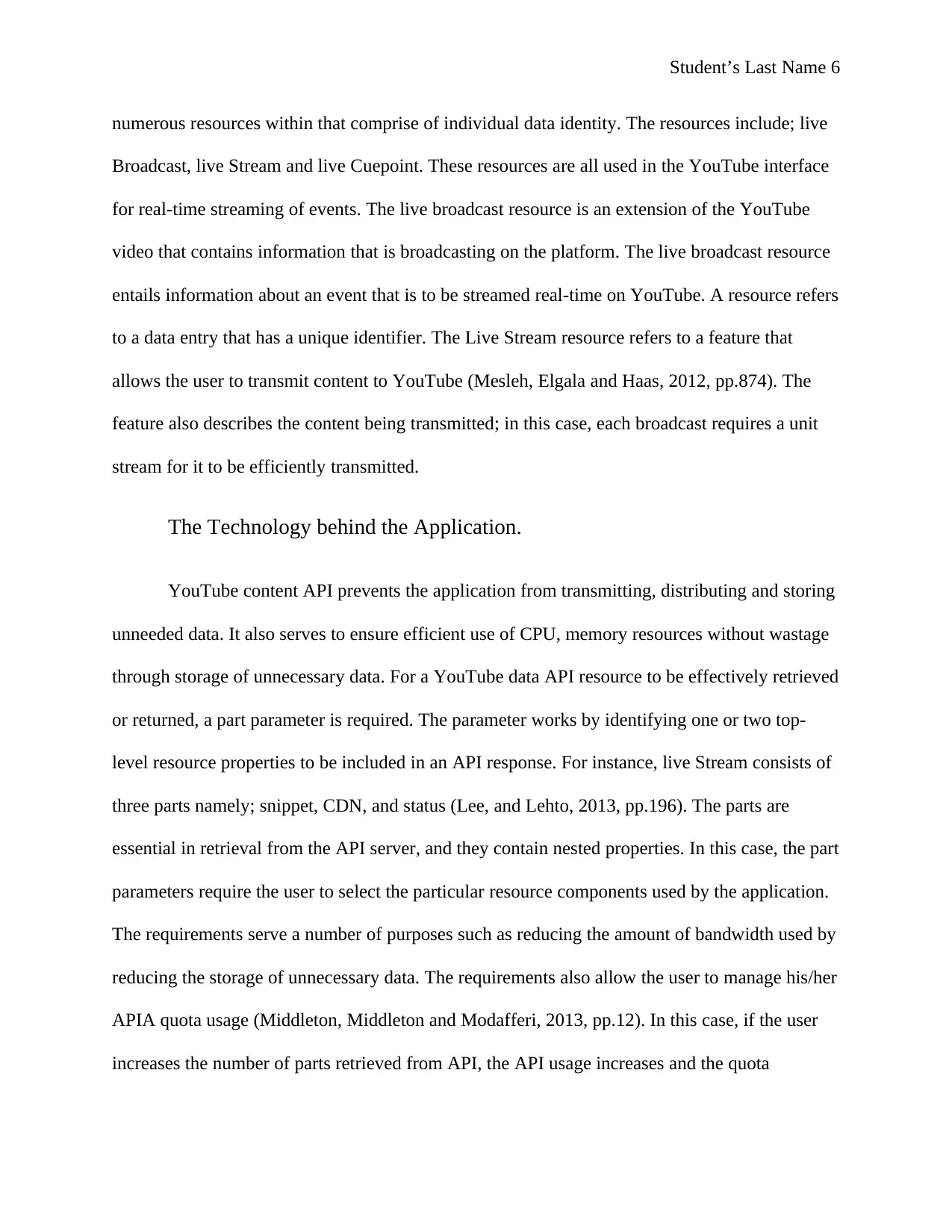
Student’s Last Name 6
numerous resources within that comprise of individual data identity. The resources include; live
Broadcast, live Stream and live Cuepoint. These resources are all used in the YouTube interface
for real-time streaming of events. The live broadcast resource is an extension of the YouTube
video that contains information that is broadcasting on the platform. The live broadcast resource
entails information about an event that is to be streamed real-time on YouTube. A resource refers
to a data entry that has a unique identifier. The Live Stream resource refers to a feature that
allows the user to transmit content to YouTube (Mesleh, Elgala and Haas, 2012, pp.874). The
feature also describes the content being transmitted; in this case, each broadcast requires a unit
stream for it to be efficiently transmitted.
The Technology behind the Application.
YouTube content API prevents the application from transmitting, distributing and storing
unneeded data. It also serves to ensure efficient use of CPU, memory resources without wastage
through storage of unnecessary data. For a YouTube data API resource to be effectively retrieved
or returned, a part parameter is required. The parameter works by identifying one or two top-
level resource properties to be included in an API response. For instance, live Stream consists of
three parts namely; snippet, CDN, and status (Lee, and Lehto, 2013, pp.196). The parts are
essential in retrieval from the API server, and they contain nested properties. In this case, the part
parameters require the user to select the particular resource components used by the application.
The requirements serve a number of purposes such as reducing the amount of bandwidth used by
reducing the storage of unnecessary data. The requirements also allow the user to manage his/her
APIA quota usage (Middleton, Middleton and Modafferi, 2013, pp.12). In this case, if the user
increases the number of parts retrieved from API, the API usage increases and the quota
numerous resources within that comprise of individual data identity. The resources include; live
Broadcast, live Stream and live Cuepoint. These resources are all used in the YouTube interface
for real-time streaming of events. The live broadcast resource is an extension of the YouTube
video that contains information that is broadcasting on the platform. The live broadcast resource
entails information about an event that is to be streamed real-time on YouTube. A resource refers
to a data entry that has a unique identifier. The Live Stream resource refers to a feature that
allows the user to transmit content to YouTube (Mesleh, Elgala and Haas, 2012, pp.874). The
feature also describes the content being transmitted; in this case, each broadcast requires a unit
stream for it to be efficiently transmitted.
The Technology behind the Application.
YouTube content API prevents the application from transmitting, distributing and storing
unneeded data. It also serves to ensure efficient use of CPU, memory resources without wastage
through storage of unnecessary data. For a YouTube data API resource to be effectively retrieved
or returned, a part parameter is required. The parameter works by identifying one or two top-
level resource properties to be included in an API response. For instance, live Stream consists of
three parts namely; snippet, CDN, and status (Lee, and Lehto, 2013, pp.196). The parts are
essential in retrieval from the API server, and they contain nested properties. In this case, the part
parameters require the user to select the particular resource components used by the application.
The requirements serve a number of purposes such as reducing the amount of bandwidth used by
reducing the storage of unnecessary data. The requirements also allow the user to manage his/her
APIA quota usage (Middleton, Middleton and Modafferi, 2013, pp.12). In this case, if the user
increases the number of parts retrieved from API, the API usage increases and the quota
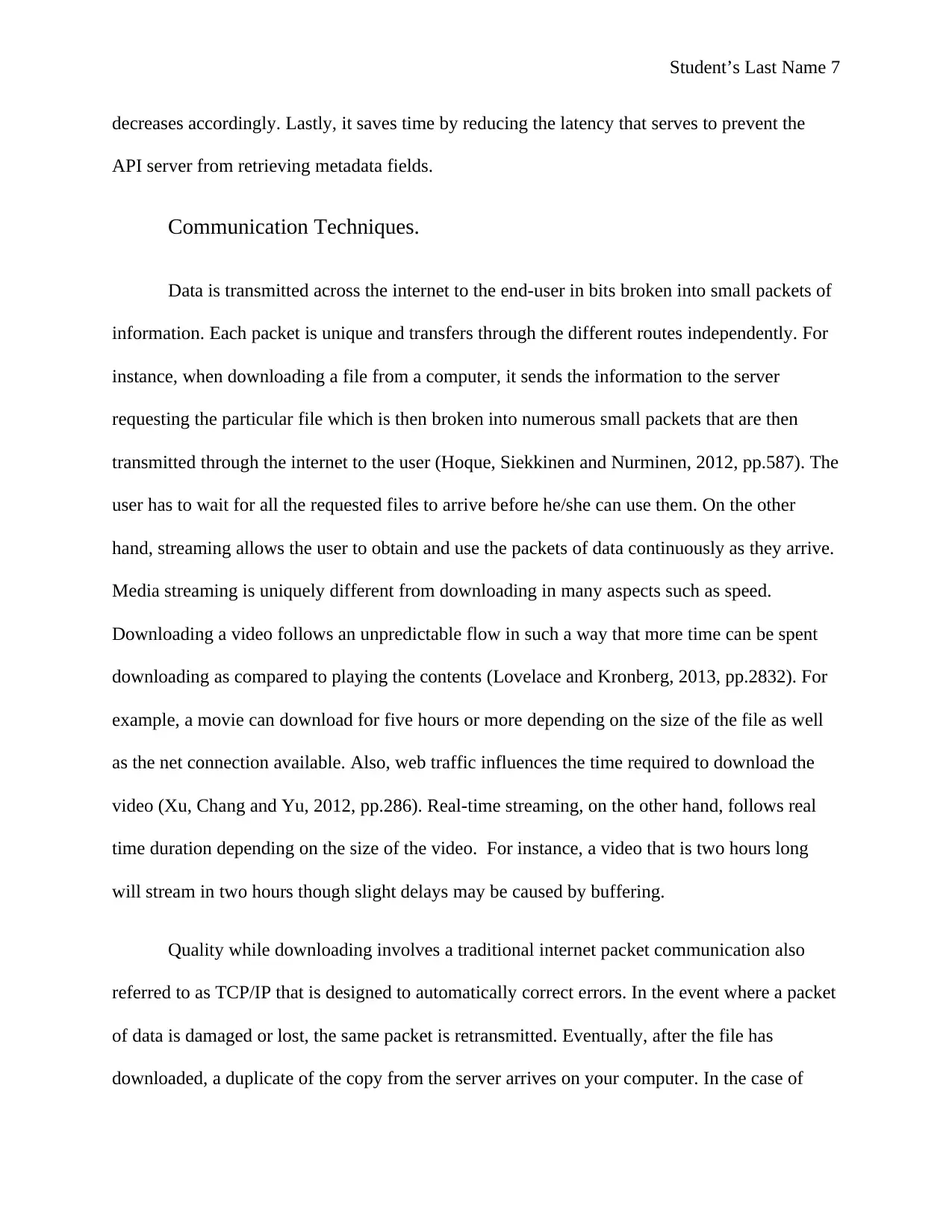
Student’s Last Name 7
decreases accordingly. Lastly, it saves time by reducing the latency that serves to prevent the
API server from retrieving metadata fields.
Communication Techniques.
Data is transmitted across the internet to the end-user in bits broken into small packets of
information. Each packet is unique and transfers through the different routes independently. For
instance, when downloading a file from a computer, it sends the information to the server
requesting the particular file which is then broken into numerous small packets that are then
transmitted through the internet to the user (Hoque, Siekkinen and Nurminen, 2012, pp.587). The
user has to wait for all the requested files to arrive before he/she can use them. On the other
hand, streaming allows the user to obtain and use the packets of data continuously as they arrive.
Media streaming is uniquely different from downloading in many aspects such as speed.
Downloading a video follows an unpredictable flow in such a way that more time can be spent
downloading as compared to playing the contents (Lovelace and Kronberg, 2013, pp.2832). For
example, a movie can download for five hours or more depending on the size of the file as well
as the net connection available. Also, web traffic influences the time required to download the
video (Xu, Chang and Yu, 2012, pp.286). Real-time streaming, on the other hand, follows real
time duration depending on the size of the video. For instance, a video that is two hours long
will stream in two hours though slight delays may be caused by buffering.
Quality while downloading involves a traditional internet packet communication also
referred to as TCP/IP that is designed to automatically correct errors. In the event where a packet
of data is damaged or lost, the same packet is retransmitted. Eventually, after the file has
downloaded, a duplicate of the copy from the server arrives on your computer. In the case of
decreases accordingly. Lastly, it saves time by reducing the latency that serves to prevent the
API server from retrieving metadata fields.
Communication Techniques.
Data is transmitted across the internet to the end-user in bits broken into small packets of
information. Each packet is unique and transfers through the different routes independently. For
instance, when downloading a file from a computer, it sends the information to the server
requesting the particular file which is then broken into numerous small packets that are then
transmitted through the internet to the user (Hoque, Siekkinen and Nurminen, 2012, pp.587). The
user has to wait for all the requested files to arrive before he/she can use them. On the other
hand, streaming allows the user to obtain and use the packets of data continuously as they arrive.
Media streaming is uniquely different from downloading in many aspects such as speed.
Downloading a video follows an unpredictable flow in such a way that more time can be spent
downloading as compared to playing the contents (Lovelace and Kronberg, 2013, pp.2832). For
example, a movie can download for five hours or more depending on the size of the file as well
as the net connection available. Also, web traffic influences the time required to download the
video (Xu, Chang and Yu, 2012, pp.286). Real-time streaming, on the other hand, follows real
time duration depending on the size of the video. For instance, a video that is two hours long
will stream in two hours though slight delays may be caused by buffering.
Quality while downloading involves a traditional internet packet communication also
referred to as TCP/IP that is designed to automatically correct errors. In the event where a packet
of data is damaged or lost, the same packet is retransmitted. Eventually, after the file has
downloaded, a duplicate of the copy from the server arrives on your computer. In the case of
Paraphrase This Document
Need a fresh take? Get an instant paraphrase of this document with our AI Paraphraser
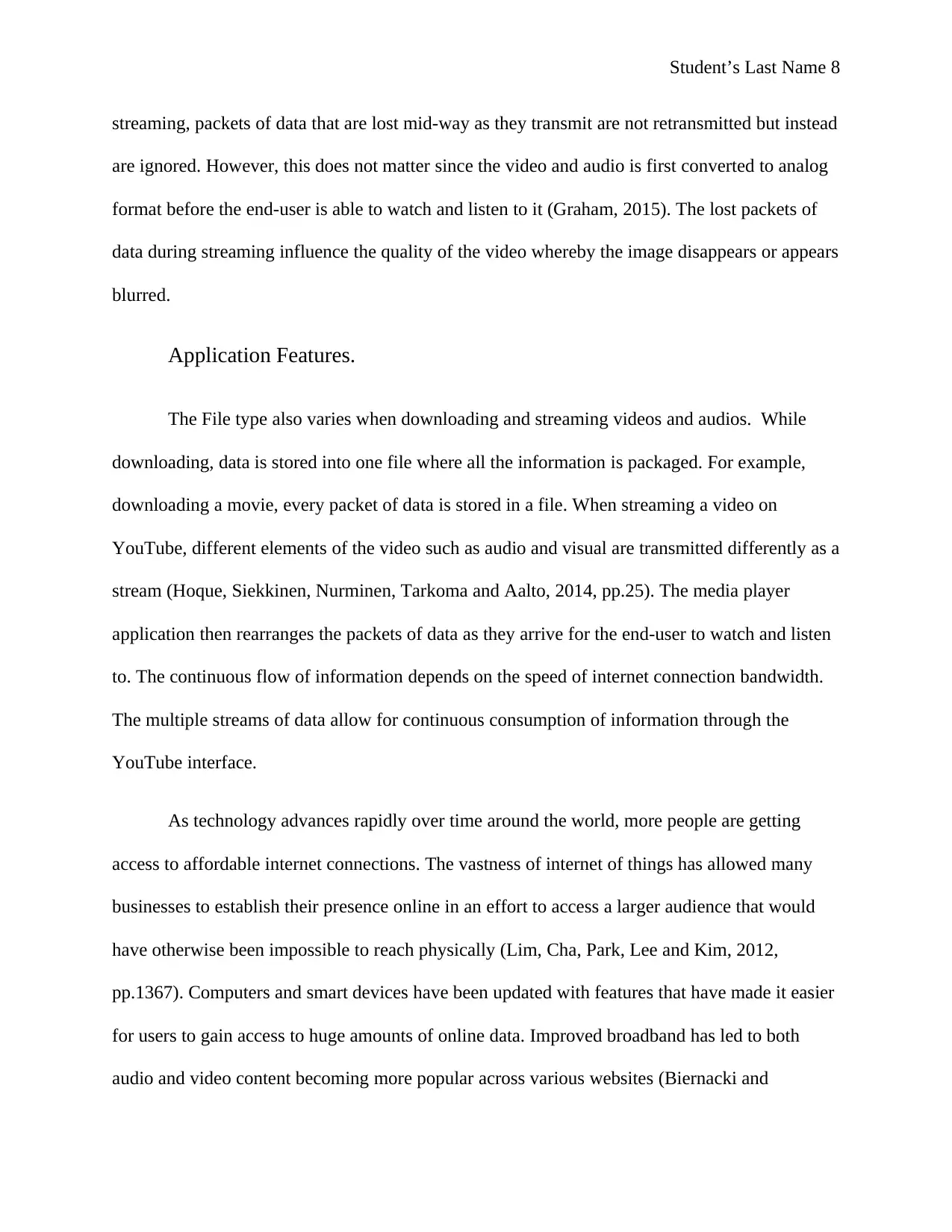
Student’s Last Name 8
streaming, packets of data that are lost mid-way as they transmit are not retransmitted but instead
are ignored. However, this does not matter since the video and audio is first converted to analog
format before the end-user is able to watch and listen to it (Graham, 2015). The lost packets of
data during streaming influence the quality of the video whereby the image disappears or appears
blurred.
Application Features.
The File type also varies when downloading and streaming videos and audios. While
downloading, data is stored into one file where all the information is packaged. For example,
downloading a movie, every packet of data is stored in a file. When streaming a video on
YouTube, different elements of the video such as audio and visual are transmitted differently as a
stream (Hoque, Siekkinen, Nurminen, Tarkoma and Aalto, 2014, pp.25). The media player
application then rearranges the packets of data as they arrive for the end-user to watch and listen
to. The continuous flow of information depends on the speed of internet connection bandwidth.
The multiple streams of data allow for continuous consumption of information through the
YouTube interface.
As technology advances rapidly over time around the world, more people are getting
access to affordable internet connections. The vastness of internet of things has allowed many
businesses to establish their presence online in an effort to access a larger audience that would
have otherwise been impossible to reach physically (Lim, Cha, Park, Lee and Kim, 2012,
pp.1367). Computers and smart devices have been updated with features that have made it easier
for users to gain access to huge amounts of online data. Improved broadband has led to both
audio and video content becoming more popular across various websites (Biernacki and
streaming, packets of data that are lost mid-way as they transmit are not retransmitted but instead
are ignored. However, this does not matter since the video and audio is first converted to analog
format before the end-user is able to watch and listen to it (Graham, 2015). The lost packets of
data during streaming influence the quality of the video whereby the image disappears or appears
blurred.
Application Features.
The File type also varies when downloading and streaming videos and audios. While
downloading, data is stored into one file where all the information is packaged. For example,
downloading a movie, every packet of data is stored in a file. When streaming a video on
YouTube, different elements of the video such as audio and visual are transmitted differently as a
stream (Hoque, Siekkinen, Nurminen, Tarkoma and Aalto, 2014, pp.25). The media player
application then rearranges the packets of data as they arrive for the end-user to watch and listen
to. The continuous flow of information depends on the speed of internet connection bandwidth.
The multiple streams of data allow for continuous consumption of information through the
YouTube interface.
As technology advances rapidly over time around the world, more people are getting
access to affordable internet connections. The vastness of internet of things has allowed many
businesses to establish their presence online in an effort to access a larger audience that would
have otherwise been impossible to reach physically (Lim, Cha, Park, Lee and Kim, 2012,
pp.1367). Computers and smart devices have been updated with features that have made it easier
for users to gain access to huge amounts of online data. Improved broadband has led to both
audio and video content becoming more popular across various websites (Biernacki and

Student’s Last Name 9
Tutschku, 2014, pp.1152). It’s now much easier for the users to play these sounds and videos
from the respective websites without having to install support applications. One is able to stream
events in real-time with little to no buffering time. In cases where the web pages do not have the
support files, they provide links that redirect the user to download the required player, showing a
list of options or him/her to choose.
The players execute the role of decoding and displaying the retrieved information at a
much faster speed that allows the user to play the video while streaming. Before different files
can be streamed, they are compacted from raw files that are very large in size and also high
quality (Lim, Cha, Park, Lee and Kim, 2012, pp.1367). These raw files are analog data that has
been captured through digitization. These files are compressed to make an ordinary file that can
be streamed. However, after a raw file has been compressed, the quality of the file reduces
significantly to become more blurry videos and in the case of audio recordings, they become
hard to understand (Uldam and Askanius, 2013, pp.20). For instance in our case, while streaming
a live event on YouTube on full-screen mode, one notices that the pictures become blurry and
more pixilated as compared to when streaming through a smaller window. Servers used while
downloading work through a web serving method such as HTTP and FTP protocols. This means
that every request sent to the server pertaining to a certain file provides the same version of the
file to every request received (Copper and Semich, 2014, pp.36). In the case of real-time
streaming, a Real-time Streaming protocol is used in such a way that the user is redirected to a
separate streaming server. Different connection speeds have different versions of the file for
instance; low-quality version allows a dial-up for a broadband connection.
Tutschku, 2014, pp.1152). It’s now much easier for the users to play these sounds and videos
from the respective websites without having to install support applications. One is able to stream
events in real-time with little to no buffering time. In cases where the web pages do not have the
support files, they provide links that redirect the user to download the required player, showing a
list of options or him/her to choose.
The players execute the role of decoding and displaying the retrieved information at a
much faster speed that allows the user to play the video while streaming. Before different files
can be streamed, they are compacted from raw files that are very large in size and also high
quality (Lim, Cha, Park, Lee and Kim, 2012, pp.1367). These raw files are analog data that has
been captured through digitization. These files are compressed to make an ordinary file that can
be streamed. However, after a raw file has been compressed, the quality of the file reduces
significantly to become more blurry videos and in the case of audio recordings, they become
hard to understand (Uldam and Askanius, 2013, pp.20). For instance in our case, while streaming
a live event on YouTube on full-screen mode, one notices that the pictures become blurry and
more pixilated as compared to when streaming through a smaller window. Servers used while
downloading work through a web serving method such as HTTP and FTP protocols. This means
that every request sent to the server pertaining to a certain file provides the same version of the
file to every request received (Copper and Semich, 2014, pp.36). In the case of real-time
streaming, a Real-time Streaming protocol is used in such a way that the user is redirected to a
separate streaming server. Different connection speeds have different versions of the file for
instance; low-quality version allows a dial-up for a broadband connection.
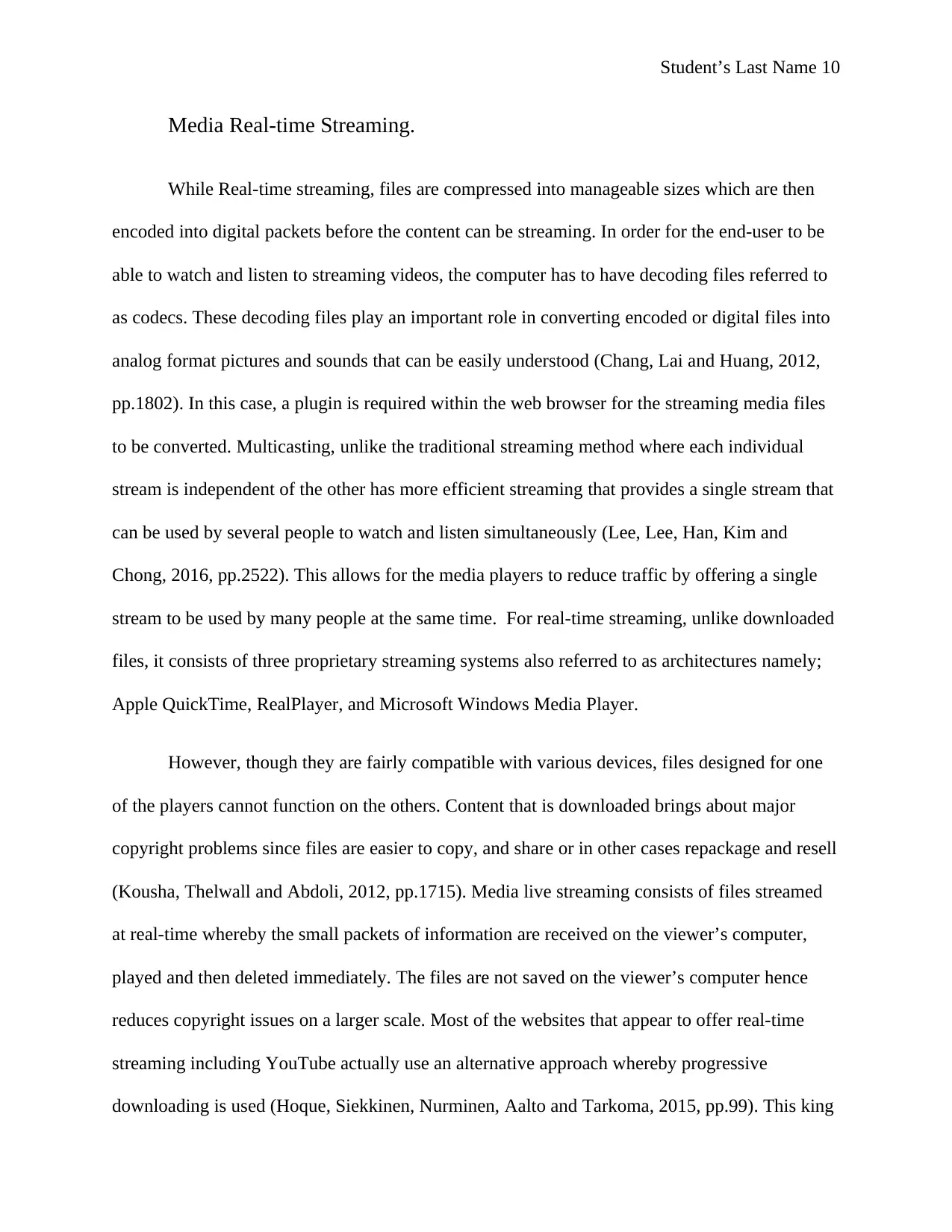
Student’s Last Name 10
Media Real-time Streaming.
While Real-time streaming, files are compressed into manageable sizes which are then
encoded into digital packets before the content can be streaming. In order for the end-user to be
able to watch and listen to streaming videos, the computer has to have decoding files referred to
as codecs. These decoding files play an important role in converting encoded or digital files into
analog format pictures and sounds that can be easily understood (Chang, Lai and Huang, 2012,
pp.1802). In this case, a plugin is required within the web browser for the streaming media files
to be converted. Multicasting, unlike the traditional streaming method where each individual
stream is independent of the other has more efficient streaming that provides a single stream that
can be used by several people to watch and listen simultaneously (Lee, Lee, Han, Kim and
Chong, 2016, pp.2522). This allows for the media players to reduce traffic by offering a single
stream to be used by many people at the same time. For real-time streaming, unlike downloaded
files, it consists of three proprietary streaming systems also referred to as architectures namely;
Apple QuickTime, RealPlayer, and Microsoft Windows Media Player.
However, though they are fairly compatible with various devices, files designed for one
of the players cannot function on the others. Content that is downloaded brings about major
copyright problems since files are easier to copy, and share or in other cases repackage and resell
(Kousha, Thelwall and Abdoli, 2012, pp.1715). Media live streaming consists of files streamed
at real-time whereby the small packets of information are received on the viewer’s computer,
played and then deleted immediately. The files are not saved on the viewer’s computer hence
reduces copyright issues on a larger scale. Most of the websites that appear to offer real-time
streaming including YouTube actually use an alternative approach whereby progressive
downloading is used (Hoque, Siekkinen, Nurminen, Aalto and Tarkoma, 2015, pp.99). This king
Media Real-time Streaming.
While Real-time streaming, files are compressed into manageable sizes which are then
encoded into digital packets before the content can be streaming. In order for the end-user to be
able to watch and listen to streaming videos, the computer has to have decoding files referred to
as codecs. These decoding files play an important role in converting encoded or digital files into
analog format pictures and sounds that can be easily understood (Chang, Lai and Huang, 2012,
pp.1802). In this case, a plugin is required within the web browser for the streaming media files
to be converted. Multicasting, unlike the traditional streaming method where each individual
stream is independent of the other has more efficient streaming that provides a single stream that
can be used by several people to watch and listen simultaneously (Lee, Lee, Han, Kim and
Chong, 2016, pp.2522). This allows for the media players to reduce traffic by offering a single
stream to be used by many people at the same time. For real-time streaming, unlike downloaded
files, it consists of three proprietary streaming systems also referred to as architectures namely;
Apple QuickTime, RealPlayer, and Microsoft Windows Media Player.
However, though they are fairly compatible with various devices, files designed for one
of the players cannot function on the others. Content that is downloaded brings about major
copyright problems since files are easier to copy, and share or in other cases repackage and resell
(Kousha, Thelwall and Abdoli, 2012, pp.1715). Media live streaming consists of files streamed
at real-time whereby the small packets of information are received on the viewer’s computer,
played and then deleted immediately. The files are not saved on the viewer’s computer hence
reduces copyright issues on a larger scale. Most of the websites that appear to offer real-time
streaming including YouTube actually use an alternative approach whereby progressive
downloading is used (Hoque, Siekkinen, Nurminen, Aalto and Tarkoma, 2015, pp.99). This king
Secure Best Marks with AI Grader
Need help grading? Try our AI Grader for instant feedback on your assignments.
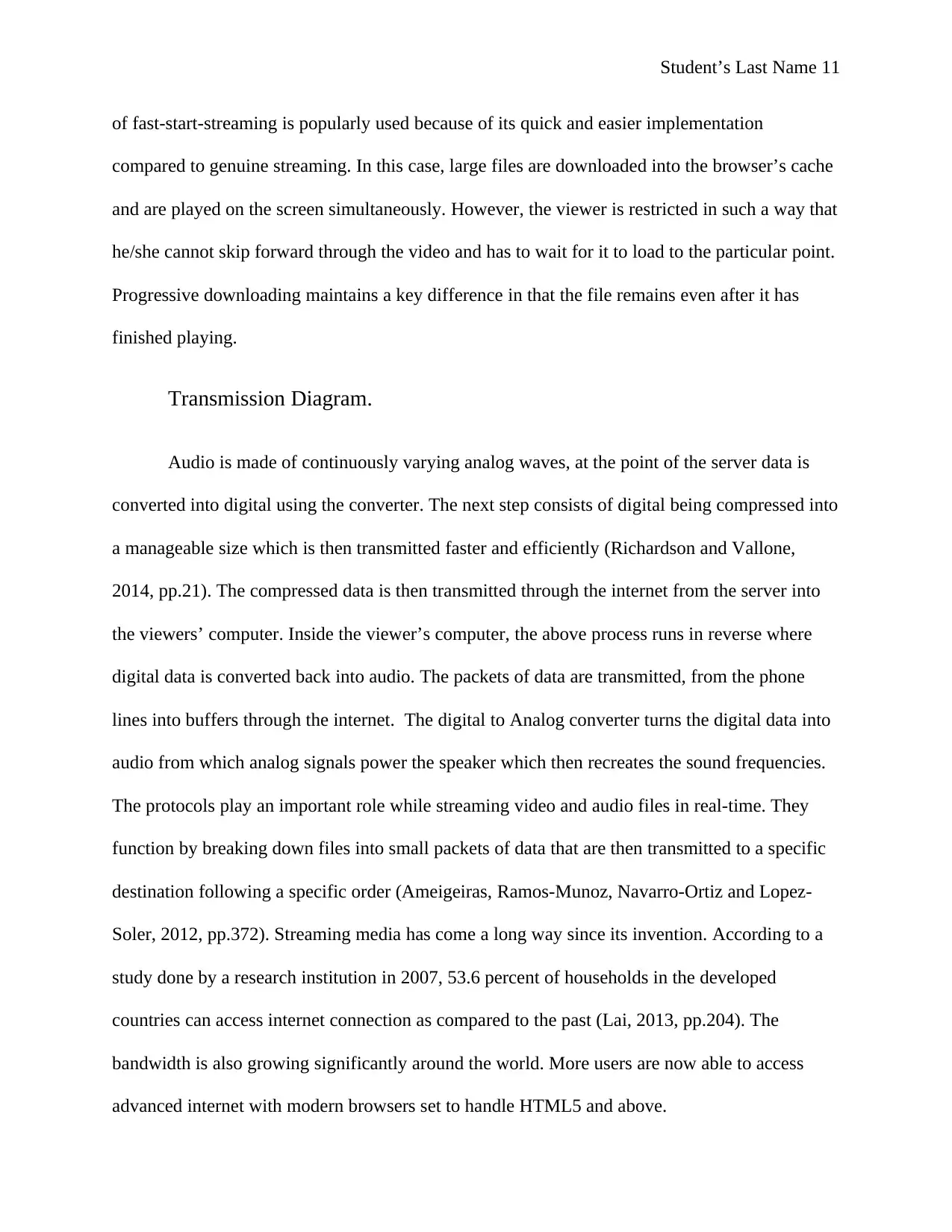
Student’s Last Name 11
of fast-start-streaming is popularly used because of its quick and easier implementation
compared to genuine streaming. In this case, large files are downloaded into the browser’s cache
and are played on the screen simultaneously. However, the viewer is restricted in such a way that
he/she cannot skip forward through the video and has to wait for it to load to the particular point.
Progressive downloading maintains a key difference in that the file remains even after it has
finished playing.
Transmission Diagram.
Audio is made of continuously varying analog waves, at the point of the server data is
converted into digital using the converter. The next step consists of digital being compressed into
a manageable size which is then transmitted faster and efficiently (Richardson and Vallone,
2014, pp.21). The compressed data is then transmitted through the internet from the server into
the viewers’ computer. Inside the viewer’s computer, the above process runs in reverse where
digital data is converted back into audio. The packets of data are transmitted, from the phone
lines into buffers through the internet. The digital to Analog converter turns the digital data into
audio from which analog signals power the speaker which then recreates the sound frequencies.
The protocols play an important role while streaming video and audio files in real-time. They
function by breaking down files into small packets of data that are then transmitted to a specific
destination following a specific order (Ameigeiras, Ramos‐Munoz, Navarro‐Ortiz and Lopez‐
Soler, 2012, pp.372). Streaming media has come a long way since its invention. According to a
study done by a research institution in 2007, 53.6 percent of households in the developed
countries can access internet connection as compared to the past (Lai, 2013, pp.204). The
bandwidth is also growing significantly around the world. More users are now able to access
advanced internet with modern browsers set to handle HTML5 and above.
of fast-start-streaming is popularly used because of its quick and easier implementation
compared to genuine streaming. In this case, large files are downloaded into the browser’s cache
and are played on the screen simultaneously. However, the viewer is restricted in such a way that
he/she cannot skip forward through the video and has to wait for it to load to the particular point.
Progressive downloading maintains a key difference in that the file remains even after it has
finished playing.
Transmission Diagram.
Audio is made of continuously varying analog waves, at the point of the server data is
converted into digital using the converter. The next step consists of digital being compressed into
a manageable size which is then transmitted faster and efficiently (Richardson and Vallone,
2014, pp.21). The compressed data is then transmitted through the internet from the server into
the viewers’ computer. Inside the viewer’s computer, the above process runs in reverse where
digital data is converted back into audio. The packets of data are transmitted, from the phone
lines into buffers through the internet. The digital to Analog converter turns the digital data into
audio from which analog signals power the speaker which then recreates the sound frequencies.
The protocols play an important role while streaming video and audio files in real-time. They
function by breaking down files into small packets of data that are then transmitted to a specific
destination following a specific order (Ameigeiras, Ramos‐Munoz, Navarro‐Ortiz and Lopez‐
Soler, 2012, pp.372). Streaming media has come a long way since its invention. According to a
study done by a research institution in 2007, 53.6 percent of households in the developed
countries can access internet connection as compared to the past (Lai, 2013, pp.204). The
bandwidth is also growing significantly around the world. More users are now able to access
advanced internet with modern browsers set to handle HTML5 and above.
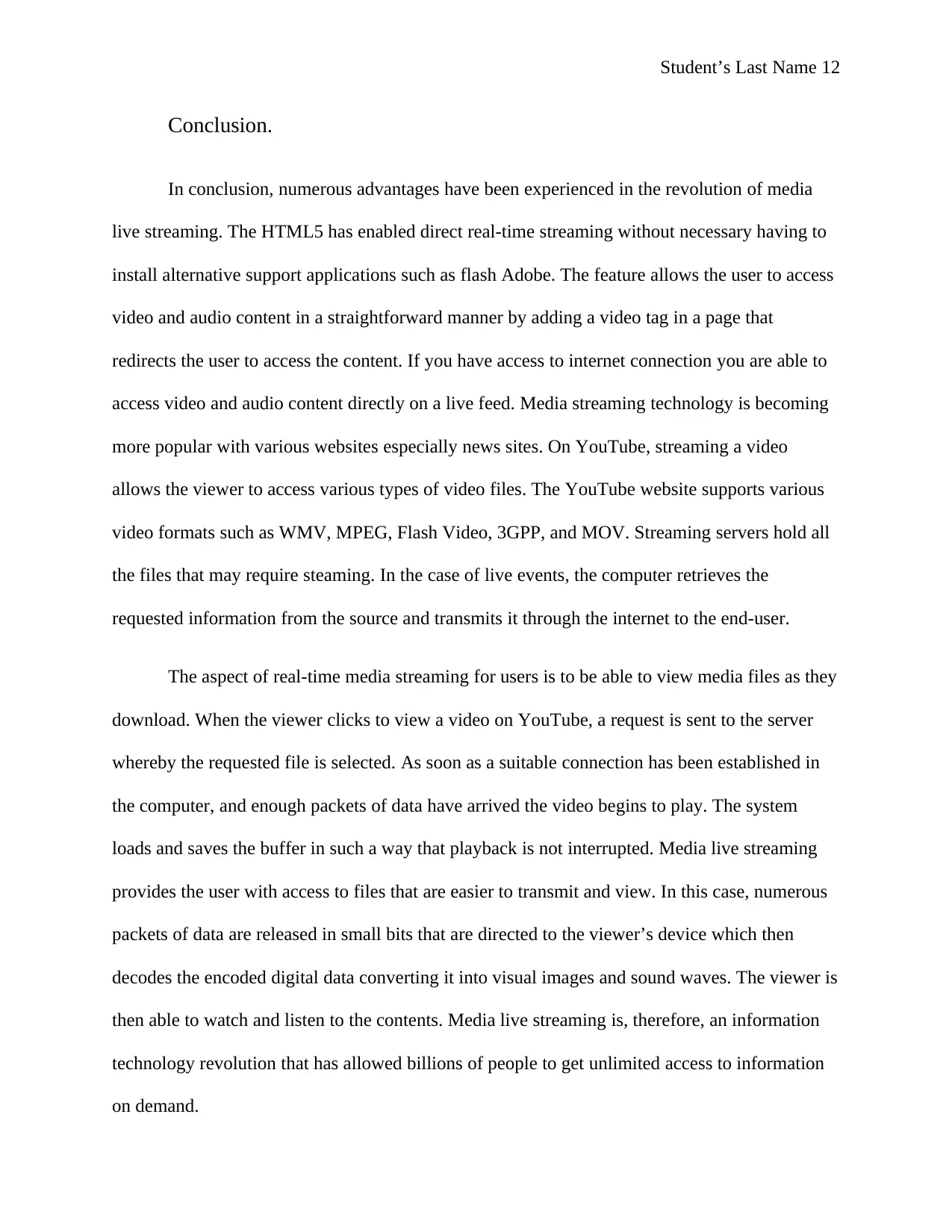
Student’s Last Name 12
Conclusion.
In conclusion, numerous advantages have been experienced in the revolution of media
live streaming. The HTML5 has enabled direct real-time streaming without necessary having to
install alternative support applications such as flash Adobe. The feature allows the user to access
video and audio content in a straightforward manner by adding a video tag in a page that
redirects the user to access the content. If you have access to internet connection you are able to
access video and audio content directly on a live feed. Media streaming technology is becoming
more popular with various websites especially news sites. On YouTube, streaming a video
allows the viewer to access various types of video files. The YouTube website supports various
video formats such as WMV, MPEG, Flash Video, 3GPP, and MOV. Streaming servers hold all
the files that may require steaming. In the case of live events, the computer retrieves the
requested information from the source and transmits it through the internet to the end-user.
The aspect of real-time media streaming for users is to be able to view media files as they
download. When the viewer clicks to view a video on YouTube, a request is sent to the server
whereby the requested file is selected. As soon as a suitable connection has been established in
the computer, and enough packets of data have arrived the video begins to play. The system
loads and saves the buffer in such a way that playback is not interrupted. Media live streaming
provides the user with access to files that are easier to transmit and view. In this case, numerous
packets of data are released in small bits that are directed to the viewer’s device which then
decodes the encoded digital data converting it into visual images and sound waves. The viewer is
then able to watch and listen to the contents. Media live streaming is, therefore, an information
technology revolution that has allowed billions of people to get unlimited access to information
on demand.
Conclusion.
In conclusion, numerous advantages have been experienced in the revolution of media
live streaming. The HTML5 has enabled direct real-time streaming without necessary having to
install alternative support applications such as flash Adobe. The feature allows the user to access
video and audio content in a straightforward manner by adding a video tag in a page that
redirects the user to access the content. If you have access to internet connection you are able to
access video and audio content directly on a live feed. Media streaming technology is becoming
more popular with various websites especially news sites. On YouTube, streaming a video
allows the viewer to access various types of video files. The YouTube website supports various
video formats such as WMV, MPEG, Flash Video, 3GPP, and MOV. Streaming servers hold all
the files that may require steaming. In the case of live events, the computer retrieves the
requested information from the source and transmits it through the internet to the end-user.
The aspect of real-time media streaming for users is to be able to view media files as they
download. When the viewer clicks to view a video on YouTube, a request is sent to the server
whereby the requested file is selected. As soon as a suitable connection has been established in
the computer, and enough packets of data have arrived the video begins to play. The system
loads and saves the buffer in such a way that playback is not interrupted. Media live streaming
provides the user with access to files that are easier to transmit and view. In this case, numerous
packets of data are released in small bits that are directed to the viewer’s device which then
decodes the encoded digital data converting it into visual images and sound waves. The viewer is
then able to watch and listen to the contents. Media live streaming is, therefore, an information
technology revolution that has allowed billions of people to get unlimited access to information
on demand.
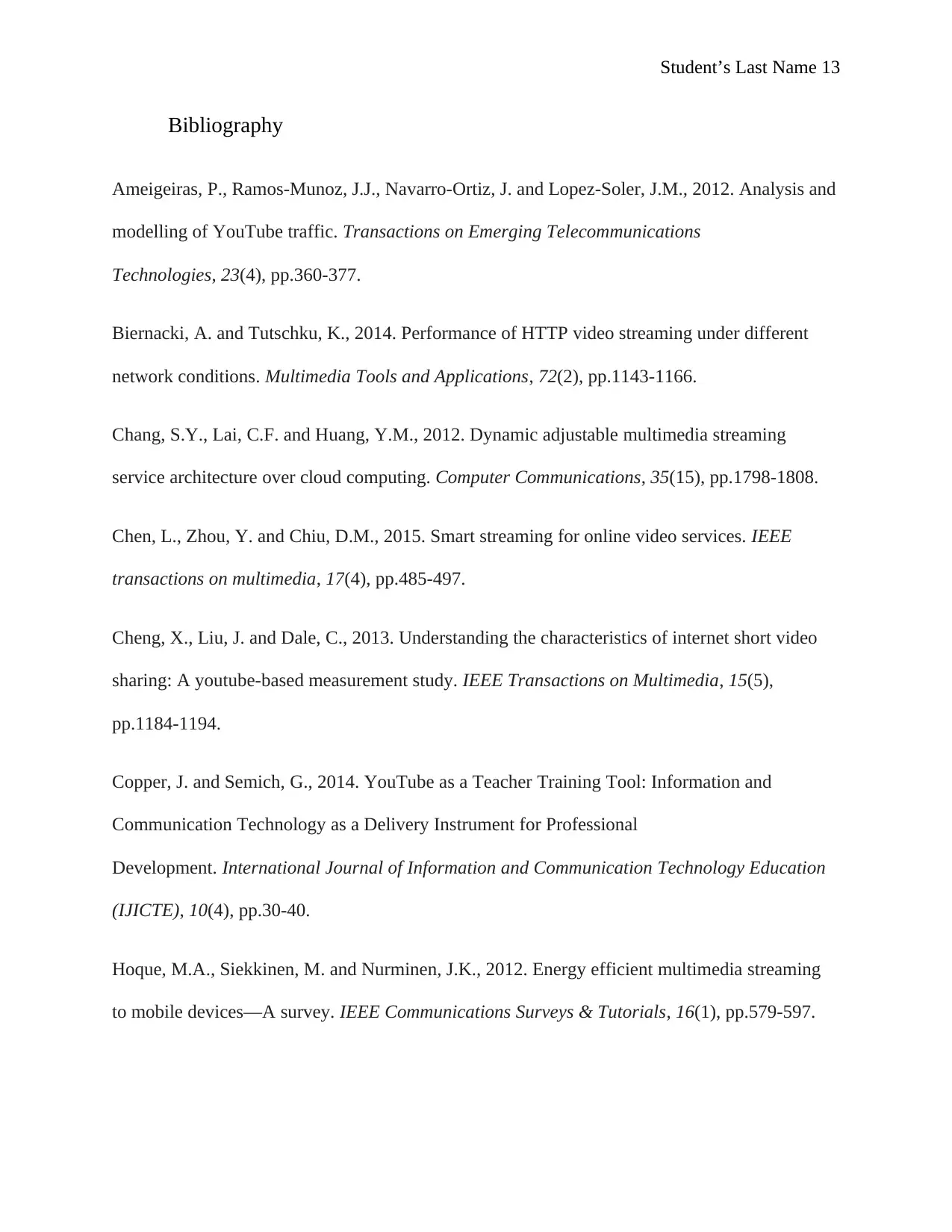
Student’s Last Name 13
Bibliography
Ameigeiras, P., Ramos‐Munoz, J.J., Navarro‐Ortiz, J. and Lopez‐Soler, J.M., 2012. Analysis and
modelling of YouTube traffic. Transactions on Emerging Telecommunications
Technologies, 23(4), pp.360-377.
Biernacki, A. and Tutschku, K., 2014. Performance of HTTP video streaming under different
network conditions. Multimedia Tools and Applications, 72(2), pp.1143-1166.
Chang, S.Y., Lai, C.F. and Huang, Y.M., 2012. Dynamic adjustable multimedia streaming
service architecture over cloud computing. Computer Communications, 35(15), pp.1798-1808.
Chen, L., Zhou, Y. and Chiu, D.M., 2015. Smart streaming for online video services. IEEE
transactions on multimedia, 17(4), pp.485-497.
Cheng, X., Liu, J. and Dale, C., 2013. Understanding the characteristics of internet short video
sharing: A youtube-based measurement study. IEEE Transactions on Multimedia, 15(5),
pp.1184-1194.
Copper, J. and Semich, G., 2014. YouTube as a Teacher Training Tool: Information and
Communication Technology as a Delivery Instrument for Professional
Development. International Journal of Information and Communication Technology Education
(IJICTE), 10(4), pp.30-40.
Hoque, M.A., Siekkinen, M. and Nurminen, J.K., 2012. Energy efficient multimedia streaming
to mobile devices—A survey. IEEE Communications Surveys & Tutorials, 16(1), pp.579-597.
Bibliography
Ameigeiras, P., Ramos‐Munoz, J.J., Navarro‐Ortiz, J. and Lopez‐Soler, J.M., 2012. Analysis and
modelling of YouTube traffic. Transactions on Emerging Telecommunications
Technologies, 23(4), pp.360-377.
Biernacki, A. and Tutschku, K., 2014. Performance of HTTP video streaming under different
network conditions. Multimedia Tools and Applications, 72(2), pp.1143-1166.
Chang, S.Y., Lai, C.F. and Huang, Y.M., 2012. Dynamic adjustable multimedia streaming
service architecture over cloud computing. Computer Communications, 35(15), pp.1798-1808.
Chen, L., Zhou, Y. and Chiu, D.M., 2015. Smart streaming for online video services. IEEE
transactions on multimedia, 17(4), pp.485-497.
Cheng, X., Liu, J. and Dale, C., 2013. Understanding the characteristics of internet short video
sharing: A youtube-based measurement study. IEEE Transactions on Multimedia, 15(5),
pp.1184-1194.
Copper, J. and Semich, G., 2014. YouTube as a Teacher Training Tool: Information and
Communication Technology as a Delivery Instrument for Professional
Development. International Journal of Information and Communication Technology Education
(IJICTE), 10(4), pp.30-40.
Hoque, M.A., Siekkinen, M. and Nurminen, J.K., 2012. Energy efficient multimedia streaming
to mobile devices—A survey. IEEE Communications Surveys & Tutorials, 16(1), pp.579-597.
Paraphrase This Document
Need a fresh take? Get an instant paraphrase of this document with our AI Paraphraser
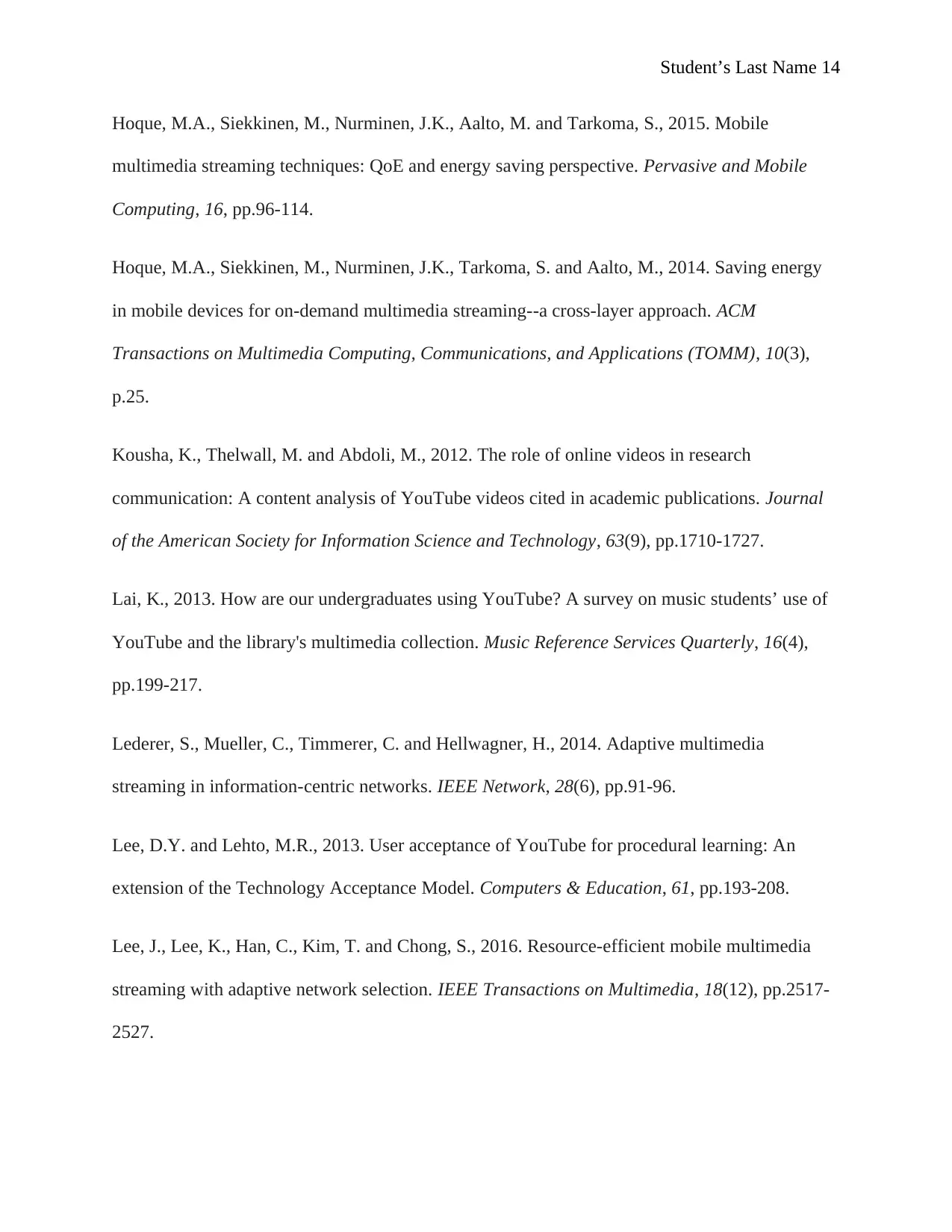
Student’s Last Name 14
Hoque, M.A., Siekkinen, M., Nurminen, J.K., Aalto, M. and Tarkoma, S., 2015. Mobile
multimedia streaming techniques: QoE and energy saving perspective. Pervasive and Mobile
Computing, 16, pp.96-114.
Hoque, M.A., Siekkinen, M., Nurminen, J.K., Tarkoma, S. and Aalto, M., 2014. Saving energy
in mobile devices for on-demand multimedia streaming--a cross-layer approach. ACM
Transactions on Multimedia Computing, Communications, and Applications (TOMM), 10(3),
p.25.
Kousha, K., Thelwall, M. and Abdoli, M., 2012. The role of online videos in research
communication: A content analysis of YouTube videos cited in academic publications. Journal
of the American Society for Information Science and Technology, 63(9), pp.1710-1727.
Lai, K., 2013. How are our undergraduates using YouTube? A survey on music students’ use of
YouTube and the library's multimedia collection. Music Reference Services Quarterly, 16(4),
pp.199-217.
Lederer, S., Mueller, C., Timmerer, C. and Hellwagner, H., 2014. Adaptive multimedia
streaming in information-centric networks. IEEE Network, 28(6), pp.91-96.
Lee, D.Y. and Lehto, M.R., 2013. User acceptance of YouTube for procedural learning: An
extension of the Technology Acceptance Model. Computers & Education, 61, pp.193-208.
Lee, J., Lee, K., Han, C., Kim, T. and Chong, S., 2016. Resource-efficient mobile multimedia
streaming with adaptive network selection. IEEE Transactions on Multimedia, 18(12), pp.2517-
2527.
Hoque, M.A., Siekkinen, M., Nurminen, J.K., Aalto, M. and Tarkoma, S., 2015. Mobile
multimedia streaming techniques: QoE and energy saving perspective. Pervasive and Mobile
Computing, 16, pp.96-114.
Hoque, M.A., Siekkinen, M., Nurminen, J.K., Tarkoma, S. and Aalto, M., 2014. Saving energy
in mobile devices for on-demand multimedia streaming--a cross-layer approach. ACM
Transactions on Multimedia Computing, Communications, and Applications (TOMM), 10(3),
p.25.
Kousha, K., Thelwall, M. and Abdoli, M., 2012. The role of online videos in research
communication: A content analysis of YouTube videos cited in academic publications. Journal
of the American Society for Information Science and Technology, 63(9), pp.1710-1727.
Lai, K., 2013. How are our undergraduates using YouTube? A survey on music students’ use of
YouTube and the library's multimedia collection. Music Reference Services Quarterly, 16(4),
pp.199-217.
Lederer, S., Mueller, C., Timmerer, C. and Hellwagner, H., 2014. Adaptive multimedia
streaming in information-centric networks. IEEE Network, 28(6), pp.91-96.
Lee, D.Y. and Lehto, M.R., 2013. User acceptance of YouTube for procedural learning: An
extension of the Technology Acceptance Model. Computers & Education, 61, pp.193-208.
Lee, J., Lee, K., Han, C., Kim, T. and Chong, S., 2016. Resource-efficient mobile multimedia
streaming with adaptive network selection. IEEE Transactions on Multimedia, 18(12), pp.2517-
2527.
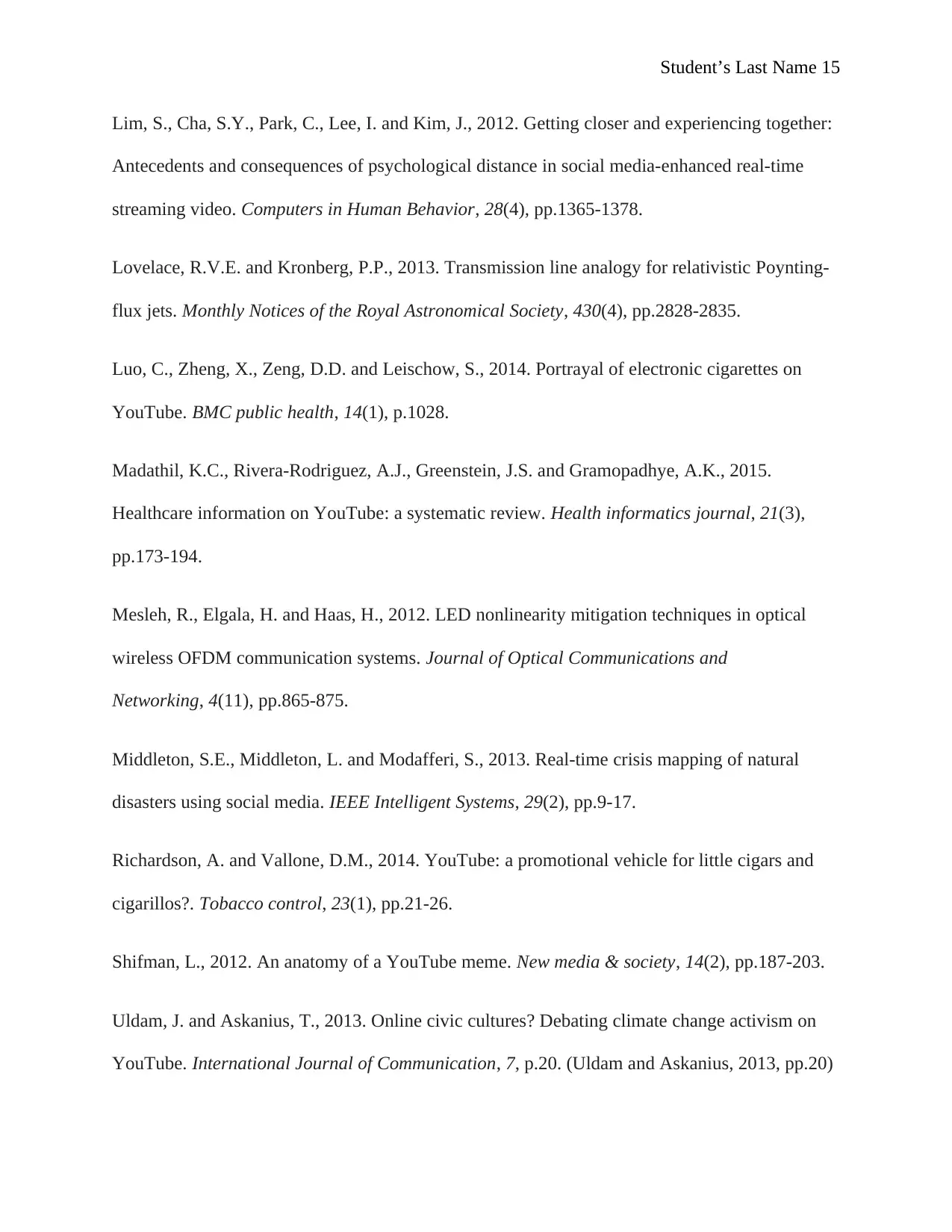
Student’s Last Name 15
Lim, S., Cha, S.Y., Park, C., Lee, I. and Kim, J., 2012. Getting closer and experiencing together:
Antecedents and consequences of psychological distance in social media-enhanced real-time
streaming video. Computers in Human Behavior, 28(4), pp.1365-1378.
Lovelace, R.V.E. and Kronberg, P.P., 2013. Transmission line analogy for relativistic Poynting-
flux jets. Monthly Notices of the Royal Astronomical Society, 430(4), pp.2828-2835.
Luo, C., Zheng, X., Zeng, D.D. and Leischow, S., 2014. Portrayal of electronic cigarettes on
YouTube. BMC public health, 14(1), p.1028.
Madathil, K.C., Rivera-Rodriguez, A.J., Greenstein, J.S. and Gramopadhye, A.K., 2015.
Healthcare information on YouTube: a systematic review. Health informatics journal, 21(3),
pp.173-194.
Mesleh, R., Elgala, H. and Haas, H., 2012. LED nonlinearity mitigation techniques in optical
wireless OFDM communication systems. Journal of Optical Communications and
Networking, 4(11), pp.865-875.
Middleton, S.E., Middleton, L. and Modafferi, S., 2013. Real-time crisis mapping of natural
disasters using social media. IEEE Intelligent Systems, 29(2), pp.9-17.
Richardson, A. and Vallone, D.M., 2014. YouTube: a promotional vehicle for little cigars and
cigarillos?. Tobacco control, 23(1), pp.21-26.
Shifman, L., 2012. An anatomy of a YouTube meme. New media & society, 14(2), pp.187-203.
Uldam, J. and Askanius, T., 2013. Online civic cultures? Debating climate change activism on
YouTube. International Journal of Communication, 7, p.20. (Uldam and Askanius, 2013, pp.20)
Lim, S., Cha, S.Y., Park, C., Lee, I. and Kim, J., 2012. Getting closer and experiencing together:
Antecedents and consequences of psychological distance in social media-enhanced real-time
streaming video. Computers in Human Behavior, 28(4), pp.1365-1378.
Lovelace, R.V.E. and Kronberg, P.P., 2013. Transmission line analogy for relativistic Poynting-
flux jets. Monthly Notices of the Royal Astronomical Society, 430(4), pp.2828-2835.
Luo, C., Zheng, X., Zeng, D.D. and Leischow, S., 2014. Portrayal of electronic cigarettes on
YouTube. BMC public health, 14(1), p.1028.
Madathil, K.C., Rivera-Rodriguez, A.J., Greenstein, J.S. and Gramopadhye, A.K., 2015.
Healthcare information on YouTube: a systematic review. Health informatics journal, 21(3),
pp.173-194.
Mesleh, R., Elgala, H. and Haas, H., 2012. LED nonlinearity mitigation techniques in optical
wireless OFDM communication systems. Journal of Optical Communications and
Networking, 4(11), pp.865-875.
Middleton, S.E., Middleton, L. and Modafferi, S., 2013. Real-time crisis mapping of natural
disasters using social media. IEEE Intelligent Systems, 29(2), pp.9-17.
Richardson, A. and Vallone, D.M., 2014. YouTube: a promotional vehicle for little cigars and
cigarillos?. Tobacco control, 23(1), pp.21-26.
Shifman, L., 2012. An anatomy of a YouTube meme. New media & society, 14(2), pp.187-203.
Uldam, J. and Askanius, T., 2013. Online civic cultures? Debating climate change activism on
YouTube. International Journal of Communication, 7, p.20. (Uldam and Askanius, 2013, pp.20)

Student’s Last Name 16
Xu, Y., Chang, Q. and Yu, Z., 2012. On new measurement and communication techniques of
GNSS inter-satellite links. Science China Technological Sciences, 55(1), pp.285-294.
Xu, Y., Chang, Q. and Yu, Z., 2012. On new measurement and communication techniques of
GNSS inter-satellite links. Science China Technological Sciences, 55(1), pp.285-294.
Secure Best Marks with AI Grader
Need help grading? Try our AI Grader for instant feedback on your assignments.
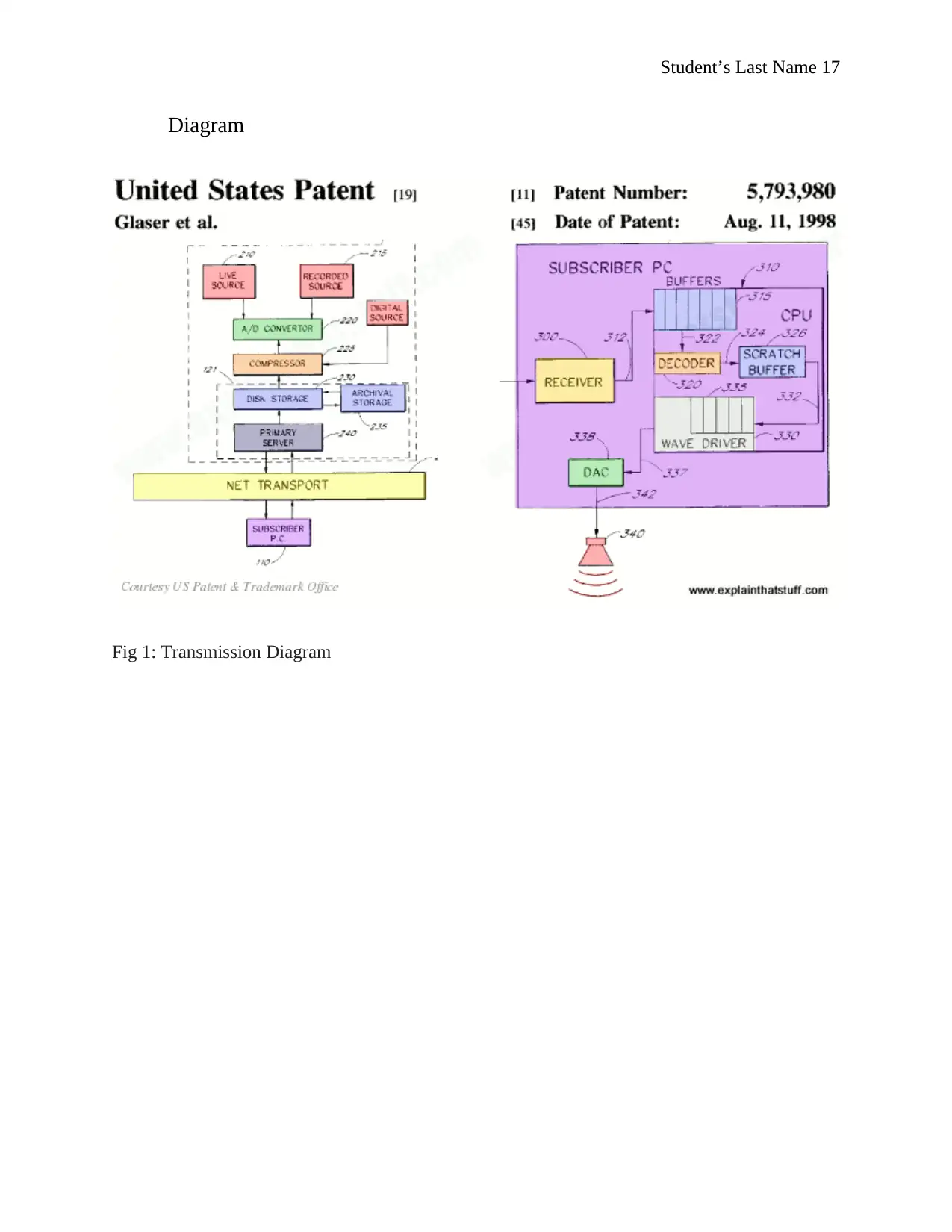
Student’s Last Name 17
Diagram
Fig 1: Transmission Diagram
Diagram
Fig 1: Transmission Diagram
1 out of 17
Related Documents
Your All-in-One AI-Powered Toolkit for Academic Success.
+13062052269
info@desklib.com
Available 24*7 on WhatsApp / Email
![[object Object]](/_next/static/media/star-bottom.7253800d.svg)
Unlock your academic potential
© 2024 | Zucol Services PVT LTD | All rights reserved.





